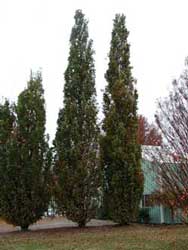Resource Library
Plant of the Week: Oak, English Columnar
The University of Arkansas System Division of Agriculture does not promote, support or recommend plants featured in "Plant of the Week." Please consult your local Extension office for plants suitable for your region.
Plant of the Week
Columnar English Oak
Latin: Quercus robur ver. Fastigiata

Trees come in an amazing variety of shapes and sizes. The physical manifestation of a tree is determined by its genetic makeup and environmental factors that modify the expression of those genes. Sure, the occasional ice storm or other mishap may affect some individuals, but genes and environment are the predominant factors. One of the unique growth forms found in many kinds of trees is called the "fastigiate" form, perhaps best represented in the columnar English oak (Quercus robur var. fastigiata).
English oak is in the white oak group with the typical species having a size, shape and life expectancy of our native white oak, Quercus alba. English oak, also called Pedunculate oak in European countries outside of the British Isles, is common in forests throughout Europe where it can reach heights and spreads of 80 feet and live to be 1,000 years old or more. The columnar form, variety fastigiata, occurs naturally throughout its range with trees usually about 60 feet tall and 10 feet wide. Because we have many superior forms of oaks in this country, only the columnar English oak is offered in the American nursery trade.
English oak leaves have seven to 12 rounded lobes that are shallower than our white oak and in the English species the leaves have a very short petiole of about one-eighth of an inch attaching the leaf to the stem. Fall color is a nondescript yellow-brown. The acorns are distinct, being borne singly, or sometimes, in clusters of two or three on a 2-inch long peduncle. The acorn is shiny brown, finger-shaped and up to 2 inches long, with the cap covering usually less than one-fifth of its length.
English oak lumber had an important role in world exploration before the Industrial Revolution. The Jamestown colonists in 1607 and Mayflower Pilgrims of 1620 both traveled to the New World in ships made of English oak. The epitaph "robur" is the Latin word for "oak board" or "strong board," an apt term to use to describe such an important tree.
The branching habit of the columnar form of English oak differs from the typical species in that it has branches that ascent at a sharp angle instead of assuming the broad right-angled branching of the typical species. When grown in isolation, the fastigiate characteristics of this botanical variety are preserved and more than 75 percent of the offspring grown from a columnar English oak parent will maintain that characteristic form.
Fastigiate trees offer a unique opportunity in landscape design. For small spaces, the columnar form can define space, provide an aerial screen or windbreak, or be used as accents. If used for screening, a row of them can be used to form a low maintenance aerial hedge. If used as an accent plant in the landscape, these living exclamation marks must be used with care, because their form can be distracting if used in the wrong place.
The columnar English oak is an easy-to-grow tree that grows fast for an oak. A tree of significant landscape size can be produced in 10 years; a real specimen can be had in 20. The only drawbacks to this tree are that seed-grown trees can have some tree-to-tree variation in size, and powdery mildew can disfigure the leaves in some summers. It is hardy from zones 4 to 8.
In recent years, hybrids of the fastigiate form with several American species in the white oak group have been produced to create forms with superior mildew resistance and varied plant forms. 'Attention' and 'Skyrocket' are columnar selections with good disease resistance.
By: Gerald Klingaman, retired
Extension Horticulturist - Ornamentals
Extension News - March 5, 2010
The University of Arkansas System Division of Agriculture does not maintain lists of retail outlets where these plants can be purchased. Please check your local nursery or other retail outlets to ask about the availability of these plants for your growing area.